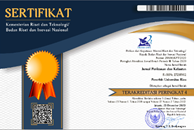The Effect Of Different Salinity On Density and Carotenoid Content Dunaliella salina
(1)
(2) Universitas Riau
(3) Universitas Riau
(*) Corresponding Author
Abstract
Keywords
Full Text:
PDFReferences
Abu . R. T. S., Al-Hooti, S., and Jacob, D. A. (2010). Optimum Culture Condition Required the Locally Isolated Dunaliella salina. Journal Algae Biomass Utln. 1(2), 12-19.
Arrokhman, S., N. Abdulgani dan D. Hidayati. 2012. Survival Rate Ikan Bawal Bintang (Trachinotus blochii) dalam Media Pemeliharaan Menggunakan Rekayasa Salinitas. Jurnal Sains dan Seni ITS. 1 (1): 32-35
Aslianti, T dan A. Nasukha. 2012. Peningkatan Kualitas Benih Ikan Kakap Merah Lutjanus sebae Melalui Pakan yang Diperkaya dengan Minyak Buah Merah Pandanus conoideus Sebagai Sumber Beta-Karoten. Balai Besar Penelitian dan Pengembangan Budidaya Laut. Gondol.4 (2) : 171-181.
associated Escherichia coli isolated
associated Escherichia coli isolated
Boyd, C. E. 2001. Water Quality Standards : pH. Global Aquaculture Alliance. USA. Pp. 42-44.
Celekli, A. and Donmez, G. 2006. Effect of pH, Light Intensity, Salt and Nitrogen Concentration on Growth and β-carotene Accumulation by a New Isolate of Dunaliellasp. World Journal of Microbiology & Biotechnology. 22, 183-189.
Gupta, S. K., A. K. Jha. A. K. Pal and V. Venkateshwarlu. 2007. Use of Natural Carotenoids for Pigmentation in Fishes. Natural Product Radiance. 6 (1) : 46-49.
Hermawan, J. (2016). Peningkatan Kandungan B-Karoten pada Fitoplankton Dunaliella salina dengan salinitas yang berbeda [Skripsi]. Surabaya: Fakultas Perikanan dan Kelautan Universitas Airlangga. 53 hlm..
Imron, M.A., Sudarno and Masithah, E. D. 2016. Pengaruh Salinitas Terhadap Kandungan Lutein pada Mikroalga Botryococcus braunii. Journal Marine and Coastal Science 5(1): 36-48.
Kebeish, R., El-Anoyouty, Y. and Hussein, A. 2014.Effect of Salinity on Biochemical Traits and Photosynthesis-Related Gene Transcription in Chlorella vulgaris.Egypt Journal Botany 54(2):281-294.
Kusdarwati, R., Mustofin, A., dan Rahardja, B. S. 2011. Pengaruh Penambahan Vitamin B12 pada Media Blotong Kering terhadap Pertumbuhan Populasi Dunaliella salina. Jurnal Ilmiah Perikanan dan Kelautan. 3 (1), 73-77.
Mahardani, D. 2017. Pengaruh Salinitas Berbeda Terhadap Pertumbuhan dan Kandungan Karotenoid Dunaliella sp. Dalam Media Ekstrak Daun Lamtoro [Skripsi]. Fakultas Pertanian. Universitas Lampung. Bandar Lampung. 54 hlm.
Pisal, S.D., and S, Lele. 2005. Carotenoid from Microalga Dunaliella salina. Indian Journal of Biotechnology. (4): 476-483.
Prieto, A., Canavatea, J. P., and Garzia-Gonzalez, M. 2011. Assessment of Carotenoid Production by Dunaliella salina in Different Culture Systems and Ope.ration Regimes. Journal of Biotechnology. (151): 180-185.
Raja, R., Hemaiswarya S and Rengasamy R. 2007. Exploitation of Dunaliella for β-carotene production. Appl Microbiol Biotechnol. 74 : 517-523.
Rusyani, E. 2001. Pengaruh Dosis Zeolit yang Berbeda Terhadap Pertumbuhan Isochrysis galbana klon Tahiti Skala Laboratorium dalam Media Komersial. [Skripsi]. Institut Pertanian Bogor, Bogor. 53 hlm.
Sudjana, Nana. 1991. Tuntunan Penyusunan Karya Ilmiah. Bandung : Sinar Baru.
Sukarman dan H. Rina. 2014. Alternatif Karotenoid Sintesis (Astaxantin) Untuk Meningkatkan Kualitas Warna Ikan Koki (Carassius auratus). Jurnal Widyariset Vol. 17, No. 3, 333-342.
Tafreshi, A. H., and Shariati. 2009. Dunaliella biotechnology: Methods and Application. Journal of Applied Microbiology. 107 (1): 14-35.
Vo, T., and Tran, D. 2014. Carotene and Antioxidant Capacity of Dunaliella Salina Strains. World Journal of Nutrition and Health. 2 (2): 21-23.
Zainuddin, M., N. Hamid, L. Mudiarti, N. Kursistyanto, dan B. Aryono. 2017. Pengaruh Media Hiposalin Dan Hipersalin Terhadap Respon Pertumbuhan dan Biopigmen Dunaliella salina. Jurnal Enggano Vol. 2, No. 1, 46-57.
Article Metrics
Abstract view : 463 timesPDF - 1230 times
DOI: http://dx.doi.org/10.31258/jpk.25.1.27-35
Copyright (c) 2020 Jurnal Perikanan dan Kelautan
Gedung Marine Center Lt 2. Fakultas Perikanan dan Kelautan Universitas Riau



